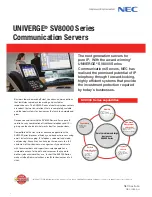
T
ROUBLESHOOTING
T
ROUBLESHOOTING
5-3
[5.1.19] Electrical Short or Overload
[5.1.20]
Remove non-essential items such as extra controller
cards (e.g SAS 6G Mezz/B, 10G Mezz/B) or HDD devices to
check for shorts and overloads.
[5.1.21]
If the system boots correctly, there may be a short or
overload associated with one of the components.
[5.1.22]
Replace each of non-essential items one at a time to
isolate which one is causing the problem.
[5.1.23]
If the problem occurs even after removing the non-
essential components, the problem has to be with the server
board, power supply, memory, or processor.
[5.1.24] Defective Components
[5.1.25]
Defective components, especially processor and mem-
ory, can cause system boot issues.
Swap the memory modules with known good memory.
Verify correct operation of the suspected memory in a
known working system.
Swap the processor with a known good processor. Verify
correct operation of the suspected processor in a known
working system.
[5.1.26] System does not boot after
Configuration Changes
[5.1.27] Hardware Changes
[5.1.28]
If the system does not boot after making changes to
hardware or adding new components, verify that the component
installed is compatible with the server.
[5.1.29] Software Changes
[5.1.30]
If you recently installed new software or new device
drivers:
Try booting into Safe Mode and uninstall the new software
or driver. If you can now boot normally, there may be a
compatibility issue between the new software or driver
and some component in your system. Contact the soft-
ware manufacturer for assistance
[5.1.31] BIOS Changes
[5.1.32]
Changes to some advanced BIOS settings can cause
boot issues. Changes to Advanced BIOS settings should only
be made by experienced users.
[5.1.33]
If the BIOS Setup Utility is accessible by pressing
F2
during boot, reset the BIOS to factory defaults by pressing
F9
.
Save and exit the BIOS Setup
Summary of Contents for W Mainboard Series S210-MBT2W
Page 25: ... 1 0 1 About the Server Chapter 1 ...
Page 31: ... 1 3 31 Functional Architecture ...
Page 121: ... 2 0 1 BIOS Chapter 2 ...
Page 187: ... 3 0 1 BMC Chapter 3 ...
Page 265: ... 4 0 1 Jumpers and Connectors Chapter 4 ...
Page 270: ... 5 0 1 Troubleshooting Chapter 5 ...
Page 275: ... 6 0 1 Installation and Assembly Safety Instructions Chapter 6 ...
Page 280: ... 7 0 1 Safety Information Chapter 7 ...
Page 289: ... 8 0 1 Regulatory and Compliance Information Chapter 8 ...















































